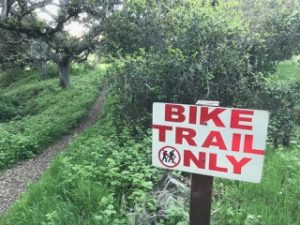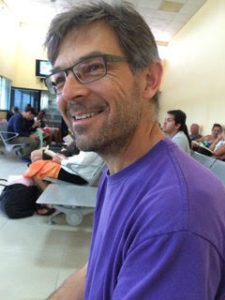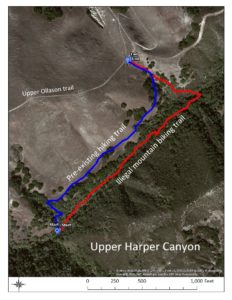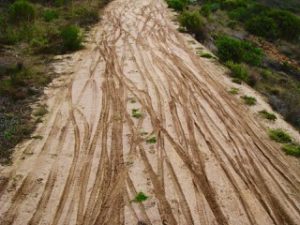Related | A Toro Timeline
Monterey County ordinance 14.12.130 A:
No person shall within a county park cut, pick, mutilate, remove or destroy any vegetation or remove soil or rock or natural material except as authorized by the Parks Department.
No person shall within a county park ride, use or be in possession of a bicycle on any trail not authorized for such use by the Parks Department
By Royal Calkins
The ruts from last winter’s heavy rains had finally healed themselves. It was a hot and dry day in September when the trio of mountain bikers dismounted at the back gate to Toro Park. They lifted their hefty two-wheelers over the fence and climbed to the other side, ignoring the “No Bicycles” sign.
They were in the mountain biker uniform of helmets, shorts and kneepads. Like most mountain bikers, they were young and fit. One wore a shirt that read “Hillbillies,” as in Highway 68 Hillbillies — a club of sorts — men and women who ride the challenging hills of the county-owned park along the highway.
I was walking my dog near the gate, off San Benancio Road, as they prepared to pedal into the park. We exchanged howdies and chatted a bit and then I tossed out a little bomb: “How do you guys feel about the efforts to restrict mountain biking in the park?”
“Well, that’s kind of obvious,” said one young man.
“We like things the way they are, “ said the slightly older fellow with “Hillbillies” on his shirt.
The third biker, the youngest, listened to the back and forth before breaking in.
“There’s only that one crazy guy who’s trying to stop us, OK? He wants to stop all the biking in the park, and that’s not going to happen.”
There is a thread of truth to that. One guy is leading the charge to impose limits on use of the park’s mountainous backcountry, which has become an unregulated magnet for mountain bikers. He’s Peter Kwiek, a hiker, Monterey County employee and musician who regularly runs across the huge park to his home on the Salinas side of the hills.
Kwiek is a hydrologist for the county Water Resources Agency. He knows how bureaucracy is supposed to work and says he simply can’t understand why the county has refused for years to exercise its authority to protect such an important public property.
There isn’t, however, any truth to the notion that Kwiek is on his own. I spoke to a dozen Toro hikers who share his view, and he has a list of dozens more. Unfortunately for Kwiek’s cause, most of them don’t want to become publicly involved for fear of harassment. Emotions run high on both sides.
At one point, Kwiek did hope to eliminate mountain biking in the park, to end the erosion it causes and the confrontations between hikers and bikers. He now acknowledges that will never happen because biking has become entrenched in the park, but he continues to press the county to do something to protect this important public property.
Some mountain bikers argue that it's a civil rights issue and building trails without official sanction is an act of civil disobedience.
Finally, after years of lobbying, Kwiek and his allies are seeing some reason for hope. Mary Adams, chairwoman of the Monterey County Board of Supervisors, agrees the status quo is unacceptable – with new trails starting wherever someone on a bike decides to veer off overland.
“I will definitely push for a solution,” Adams said recently after meeting with Kwiek and a representative of the bikers, Ken Chrisman.
“The situation out there now is unacceptable,” said Adams, whose district takes in the park,, “but with the county’s $13 million budget shortfall, the question is how.”
Adams has assigned aides to research the subject thoroughly and come up with recommendations. She’s hoping for progress before her time as chairwoman expires at year’s end, but the press of county business probably will push the timeline back into 2018.
Chrisman, a building contractor and avid mountain biker, correctly notes that park rangers a decade or so ago informally gave permission to the bikers to use picks and shovels to start fashioning what is now a rather impressive network of trails. Supervisor Adams’ office confirmed that the unofficial approvals were given for some but not all of the trails. Chrisman agrees with Adams that the county should step up and manage the park better, but he is adamant that it remain open to biking.
“The hikers have all sorts of places to hike but for mountain biking there is no place around here like Toro,” he said.
With support from studies elsewhere, Chrisman also argues that hikers cause as much damage to trails as bicyclists and that the cattle roaming the park cause significantly more.
Responsibility for deciding how the park is used and for regulating those uses clearly rests with the county but, for reasons mostly unknown, county officials have mostly looked the other way. When an organization proposed adding softball diamonds to the park, others, largely from the cross country running community, complained and beat back the idea. In contrast the hikers’ complaints about unsanctioned mountain biking have been all but ignored.
Kathryn Ramirez, a member of the Salinas Union High School board, also has pressed county officials to start regulating biking in the park. She got interested in the subject after some clashes between some mountain bikers and her son’s high school cross country team, which practices and races at the park..
“The county is slow at everything it does unless (Supervisor Luis) Alejo gets into something,” Ramirez said. “Then it will move faster. They are not hiring the right people who can move on things and take the parks and the county for that matter into the 22nd Century. They are operating on a hidden and arcane ‘county process.’”
“At the recent Parks Commission meeting an idea was brought forward by a person from the public to look into what Santa Clara County does with their parks, and a supervisor got excited and said they will look into it,” Ramirez continued. “Isn’t that what they should be doing if they want to create future success in any of their departments? Shouldn’t their managers be going and looking at other successful programs and policies that can potentially generate revenue for Monterey County?”
Similar trail debates have taken place wherever there are hills and bikers. Some localities, such as Bend, Ore., and Sedona, Ariz., have created clear guidelines on where trail riding is acceptable. But mountain bikers in general argue that they have a right to equal access to publicly owned property. Some even argue that it is a civil rights issue and that building trails without official sanction amounts to an appropriate act of civil disobedience. Bike Magazine editor Vernon Felton put out a video last year comparing wilderness mountain bikers to civil rights activists, and others have made the same argument in blogs and elsewhere, sparking much debate.
Some mountain bikers cite Marin County as an example of good relations between hikers, bikers and government entities that manage the trails. But one Marin agency has cited at least 28 mountain bikers this year for illegal riding, and a 50-year-old hiker there was injured last month in an altercation with three cyclists.
Not far from Toro, bikers have access to a giant network of bike trails at Fort Ord, but they lack the elevation gain and drama of Toro. Limited mountain biking is also allowed at Garland Park in Carmel Valley.
Users co-exist on multi-use trails at Wilder Ranch State Park near Santa Cruz.
Santa Cruz County has significantly more options than Monterey County, starting with one of the best sites in the state, Wilder Ranch State Park, with 34 miles of trails covering a wide variety of terrain.
The most challenging Santa Cruz site is the Soquel Demonstration State Forest, also known as Demo, featuring long climbs and difficult descents. Bikes are also allowed at the DeLaveaga and Pogonip parks in Santa Cruz, Nisene Marks State Park above Aptos, and elsewhere.
Mountain biking is allowed in only a few California state parks. A petition is currently circulating to urge the federal government to open all national parks to mountain biking, but its chances are slim.
Kwiek scoffs at the civil rights argument and says he has been threatened and intimidated by mountain bikers on a couple occasions. To demonstrate what a poor job the county has done managing and monitoring the park, he cited the nine-mile long Pipelines Trail, perhaps the most sophisticated and challenging of several trails that have been created with no official stamp of approval.
“The Pipeline Trail is held up as a model trail project done with complete sanction of county parks officials,” Kwiek said in an email. “Yet there is no official documentation of its installation even though it is well maintained and professionally constructed.”
“My public information request yielded zero items,” he continued. “The complete absence of any official paper trail about its approval and construction, let alone any environmental considerations, is even more striking.”
There are no signs marking the Pipeline trailhead but, as Kwiek says, there are “conspicuously well-maintained signs on the trail that say ‘No Hikers.’”
 The trail apparently was crafted early this decade by the Highway 68 Hillbillies, who also take credit for converting hiking trails to biking trails in Marks and Harper canyons.
The trail apparently was crafted early this decade by the Highway 68 Hillbillies, who also take credit for converting hiking trails to biking trails in Marks and Harper canyons.
“An important overriding point here is that there are no documents to review,” Kwiek said. “No way for the public to know what was approved and how, what is official and what isn’t. “
The standard line from county officials is that they simply don’t have the staffing to regulate backcountry activities. The result has been a free-for-all on the slopes.
Aggravating things, the county park system has been a bureaucratic black hole for several years, its leadership rapidly turning over since 2013. While it once was a freestanding entity within the county structure, it was absorbed last year by another department, the county’s Resource Management Agency, which was struggling to keep up with county business before taking on the additional responsibility.
Since 2013, leadership of the county’s parks has been fragmented and subject to constant change. One park director lasted a year and was followed briefly by an interim director on loan from another county department. Next came another full-time parks director, Mark Mariscal, who began the process of bringing order to the trail but who retired after just 13 months.
Mariscal started a committee of hikers and bikers to hash out a compromise but it fell apart, partly because the park was closed to the public for months while being used as a base camp to firefighters working the Soberanes fire near Big Sur.
Next, a Resource Management Agency planner was assigned to oversee the county parks, which include Laguna Seca and six others. He, too, moved on within months.
Then, Cam Sanchez, the retired police chief of Santa Barbara, was hired late last year as a temporary “executive management specialist” and told to create order in the parks.
But rather than having Sanchez focus on Toro, RMA Director Carl Holm assigned him to develop management plans for all the county parks, starting with San Lorenzo Park in King City.
Sanchez was handicapped by a bare-bones staff and serious restraints on his own time. Under his county contract, he is paid $113 an hour but is restricted to just 960 hours in a year. That works out to 24 weeks of full-time work. He reached his limit for this year over the summer.
In March, local biking groups distributed flyers announcing a series of formal mountain bike races in Toro late that month. When Sanchez was asked how the county would mitigate damage to trails still sloppy from winter rains, he replied in an email, “I had not heard about this event.”
Kwiek peppered county officials with requests for information about the races, the permitting process and any payments that bike organizations would make to the county. The response: We’ll get back to you.
County records show that biking groups have paid token amounts for organized races, on the order of $500 per event. In contrast, organizers of a Spartan Race obstacle course event paid the county $40,000 for use of the park over this year’s Memorial Day weekend. To accommodate the event, the county closed the park to the public for the duration – apparently without Board of Supervisors’ permission.
Despite his lifetime in law enforcement, Sanchez called himself a “parks guy” and told Monterey County Weekly last winter, “Illegal trails are something we take very seriously. It shouldn’t be happening.”
It shouldn’t, but it is.
Throughout all the controversy, the mountain bikers have consistently argued, correctly, that they outnumber the hikers and, incorrectly, that Kwiek is a lone wolf. One example of his support came from Steve Shimek, a noted environmentalist active in marine biology. He is a regular hiker at Toro and Jacks Peak.
In 2016, Shimek complained to the county Parks Commission about the “attitude of entitlement openly expressed by mountain bikers, safety for hikers, financial sustainability of Toro Park and the threat to resources.”
“Mountain bikers are very severely impacting Toro Park to the point that they have largely displaced equestrian users and disheartened backcountry hikers,” Shimek wrote.
“In Marks Canyon, many cubic yards of soil have been removed, deep trenches dug, and a snaking, banked bike trail has been constructed leading into a series of steep dips, jumps and hills, all in an area designated as hikers only … . Bare dirt is eroding into the nearby creek.”
Shimek proposed signage, citation of riders not following the rules, cancellation of scheduled races, professional evaluation of the existing trails and possible closure of Pipeline.
The county also has heard from several people on the other, better organized side.
In a May 2016 letter, middle school teacher Kelly Damschen told about coaching bike riders ranging from 7 year olds to high schoolers to adults. She leads clubs at three schools and volunteers as a coach for the Salinas and Palma High School mountain bike teams.
“Toro Regional Park’s backcountry provides training grounds for high school racers looking to have an edge over their fierce competitors,” she wrote. “It also provides a chance for kids and adults alike to see their county from a different perspective. From 1,800 (feet), their world gets a little bigger as they gaze from the mountains of Big Sur across the bay to Santa Cruz and beyond the valley to Fremont Peak.”
Like some of the Toro Park valleys, the debate is deep and wide, though there is agreement on one point. It’s a county park and the county should stop making excuses and take charge.
Have something to say about this story? Send us a letter.


